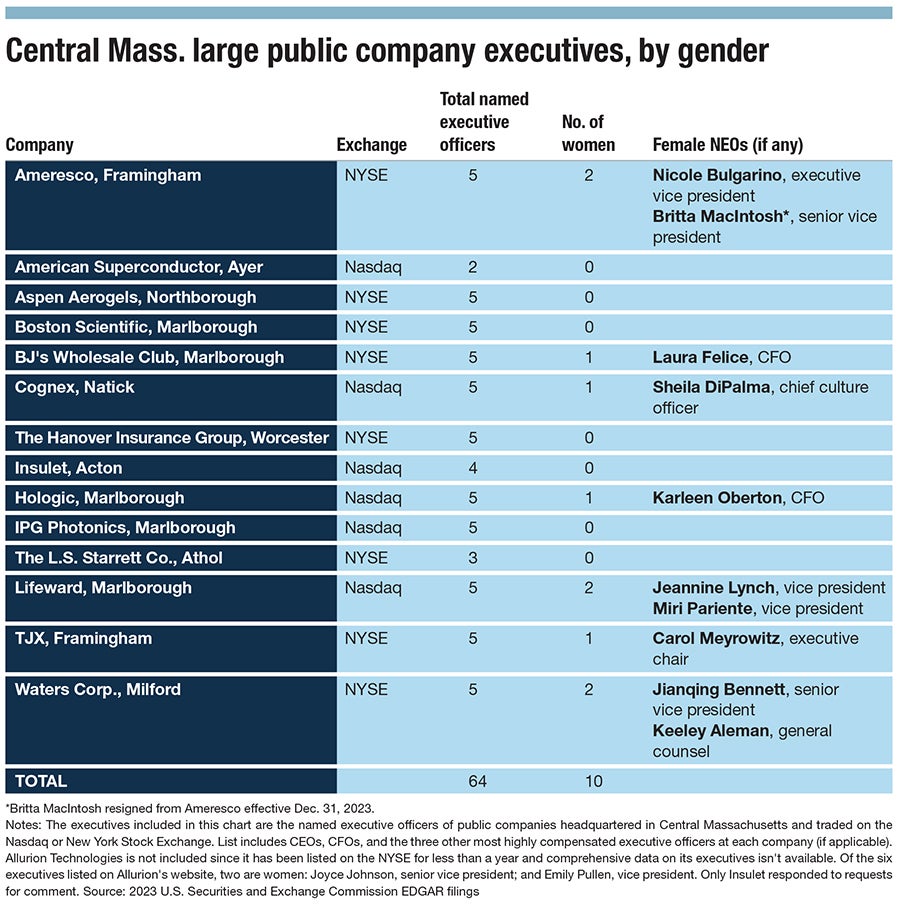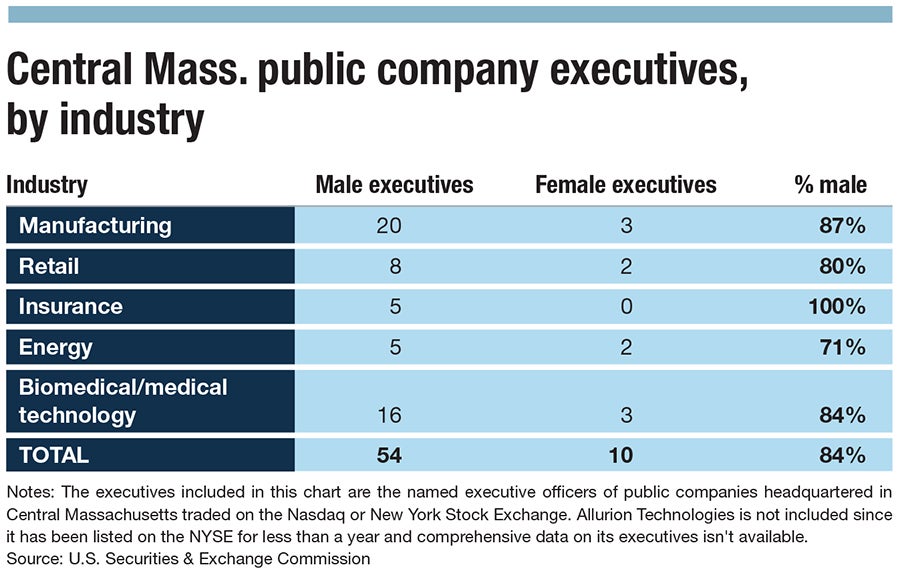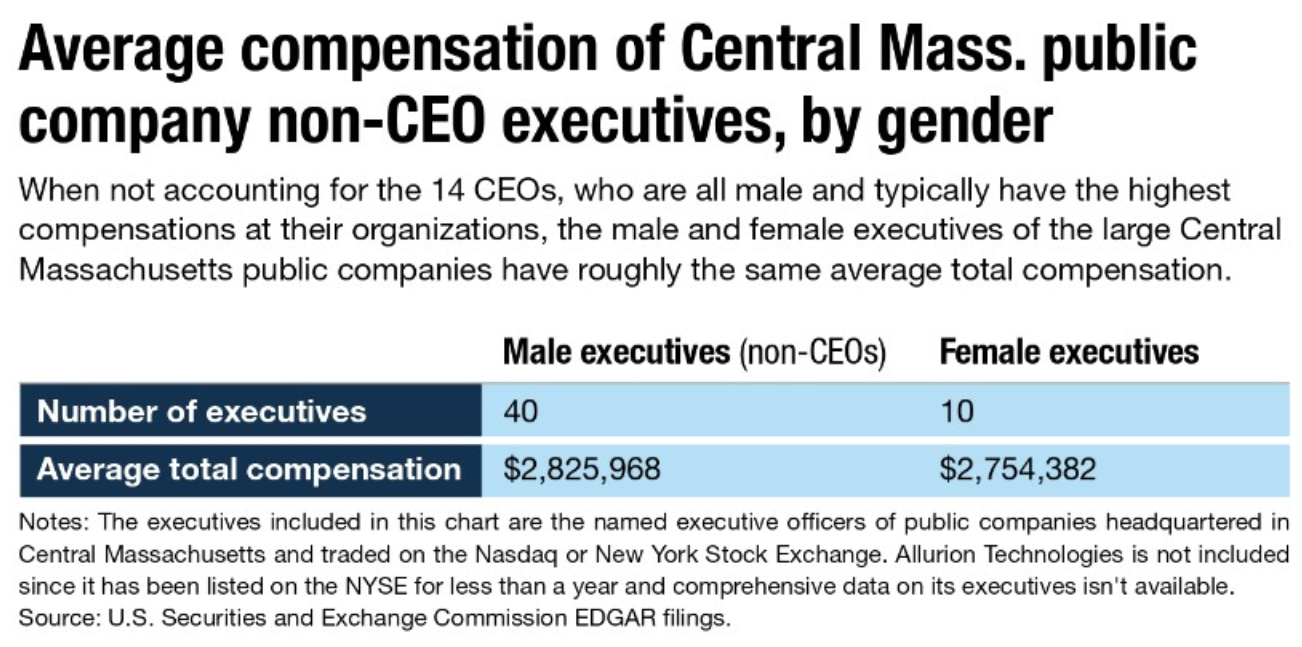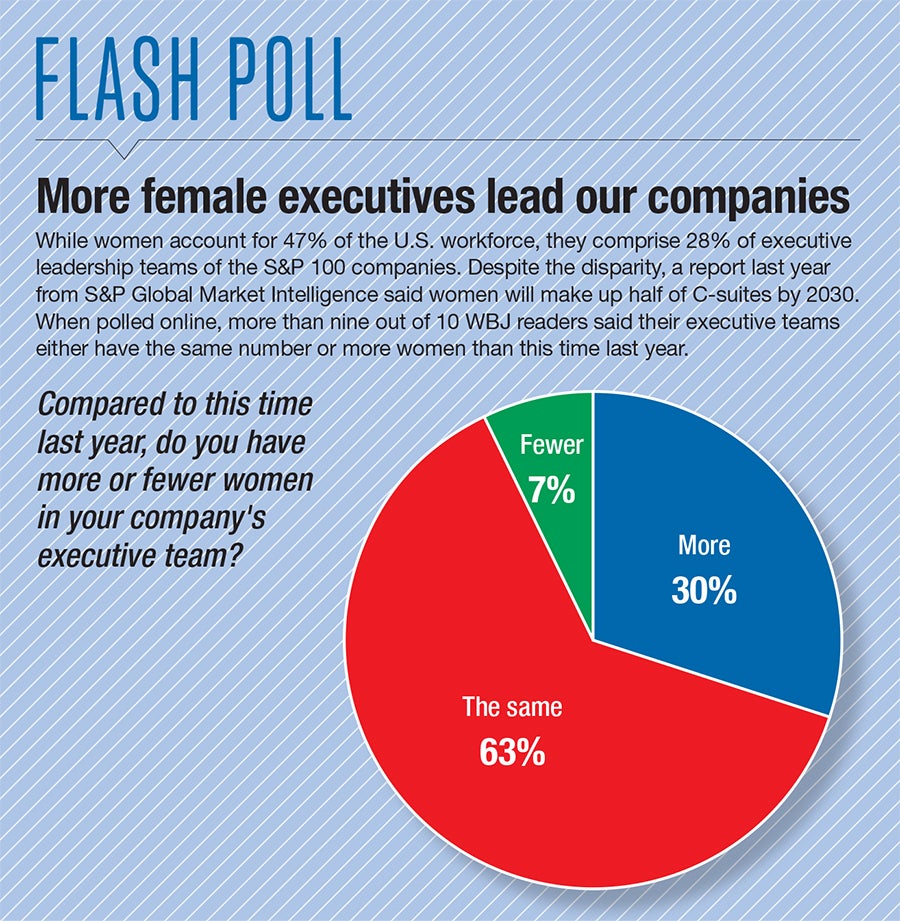The situation in Central Massachusetts, where 15.6% of named executive officers are female, largely mirrors the Massachusetts rate of 16.1% determined in a statewide census.
Get Instant Access to This Article
Subscribe to Worcester Business Journal and get immediate access to all of our subscriber-only content and much more.
- Critical Central Massachusetts business news updated daily.
- Immediate access to all subscriber-only content on our website.
- Bi-weekly print or digital editions of our award-winning publication.
- Special bonus issues like the WBJ Book of Lists.
- Exclusive ticket prize draws for our in-person events.
Click here to purchase a paywall bypass link for this article.
In 2015, the New York Times created a stir in the business world by finding a unique way to present the reality of corporate America's glass ceiling using a straightforward-yet-alarming fact: More men named John lead S&P 1500 firms than women of any name.
A 2023 analysis by Bloomberg of the smaller S&P 500 found the amount of female CEOs had finally surpassed the amount of Johns among those index companies. With the emergence of the #MeToo movement and increased attention being paid to diversity, equity, and inclusion, it might be tempting to conclude the male domination of America’s corporate boardrooms will soon be a thing of the past.
Available statistics say otherwise, including in Central Mass., where 84.4% of top-paid public company executives are male. This statistic came from a review by WBJ of 2023 Securities and Exchange Commission filings made by the 14 publicly traded companies headquartered in Central Massachusetts and traded on either the New York Stock Exchange or Nasdaq.

If the region’s largest public corporations are going to have C-suites representing the makeup of their employee bases, their client profiles, or the communities that they operate in, more concrete action is needed.
“Culture needs to start from the top. We have more women taking on roles below the C-suite, it's just a question of how to get them into the next level,” said Ann LaFrance, a member of the corporate board committee of The Boston Club, a Beverly-based nonprofit focused on elevating women to leadership positions. “That culture where you like to bring on people who are like you is part of the problem, but it’s a difficult one to resolve.”

The stats
In their annual reports to the SEC, publicly traded companies must disclose the amount and type of compensation paid to CEOs, CFOs, and the three next most highly-compensated executives. These are generally referred to as named executive officers. WBJ’s examination of these filings found 54 of the 64 of these executives were male, and eight of the 14 companies had no female representation among their named executive officers.
As has been the case since the May 2022 resignation of Shacey Petrovic, then president and CEO of Acton medical device company Insulet, no Central Mass. public company is led by a woman.
“At Insulet, we believe diverse perspectives, thoughts, experiences, and backgrounds within our workforce are vital to our overall success. Gender diversity, including having female executives, is crucial for fostering innovation, encouraging collaboration, and cultivating a vibrant culture,” said spokeswoman Angela Wiczek. “Insulet's dedication to gender parity has been recognized by the Women's Forum of New York at the Breakfast of Corporate Champions, an event honoring companies with 40% or more women on their boards. Currently, Insulet’s Board has six females Directors out of 11.”
None of the other 14 companies in WBJ's report responded to requests for comment by press deadline.

Differences in experience, titles, and industries make direct comparisons of salaries difficult for those 64 executives, but available statistics suggest an income gap between genders. Even when CEOs are excluded, a comparison of total compensation among the 64 executives found the males earn $71,586 more on average annually than the females.
The situation in Central Massachusetts, where 15.6% of named executive officers are female, largely mirrors the Massachusetts rate of 16.1% determined in a statewide census of the top 100 earning public companies conducted by The Boston Club.
As part of its census, The Boston Club often offers support to companies lacking female representation on their C-suite, but the interest from those companies in actually addressing the issue can vary, said LaFrance.
“Sometimes it’s hard to actually get a contact to respond,” LaFrance said. “Often we try to meet with companies who are the stars to see how they’ve succeeded. Those tend to be more production conversations.

“A lot of the time we hear from companies who are lagging that they’ve tried, but they claim there just aren’t any good women candidates around,” she added.
This is called the purple squirrel problem, LaFrance said, where a laundry list of required job experience, education, and other qualifications make the ideal female candidate as impossible to find as a violet-hued rodent.
The Boston Club’s December report points out some sustained progress has been made in gender parity. All companies featured in the report had at least one woman director or one woman executive officer – the third year in a row that was the case.
Yet, a number of other metrics included in the report remain relatively stagnant.
Of the companies surveyed, 39 had no women among their top paid executives, a slight improvement from 2022 when the number was 40 companies.
Trending in the opposite direction, seven companies had an executive suite at least 50% female, down from 10 in 2022.
Decades to parity
Gender parity on corporate boards in the U.S. will not be achieved until 2044, according to the 2023 Gender Diversity Index report conducted by 50/50 Women on Boards, a California nonprofit. Citing that finding, The Boston Club’s report pulled no punches when describing the sluggish rate of improvement.

“There is no plausible reason for it to take two more decades for census companies – or any publicly traded companies, for that matter – to achieve gender parity and a more representative share of people from underrepresented minorities in the C-Suite and in the boardroom,” the report’s conclusion reads.
A broader report of companies included in the Russell 3000 Index published in August by S&P Global Market Intelligence in New York had slightly more optimistic findings, determining companies who are part of that index are on track to reach gender parity in senior leadership sometime between 2030 and 2037.
Yet, even that report found 7% of current North American CEOs whose companies are included in the Russell 3000 are women, suggesting the glass ceiling around the top leadership position remains the thickest.

As you go up the corporate pyramid, the amount of females you find shrinks, said Jean Beaupre, dean of the School of Business and lead researcher for the Susan West Engelkemeyer Institute for Women’s Leadership at Nichols College in Dudley.
“We need to examine what bias is in that hiring process,” Beaupre said. “Obviously for decades, men have traditionally dominated those roles, so there’s a sense of familiarity in what a CEO looks and sounds like.”
On top of bias, a lack of diversity in who hires CEOs is an influence, said Valerie Zolezzi-Wyndham, the founder of Promoting Good, an Upton-based consulting firm specializing in assisting companies with diversity, equity, and inclusion.

“If you think about who hires the CEO, it’s the board,” she said. “It’s really important for boards to have gender and other representation so different perspectives inform decision making.”
Recruitment firms often play a role in the C-suite hiring process. Zolezzi-Wyndham said firms authentic in their desire to increase gender diversity need to look at the track record of recruitment firms in hiring diverse candidates.
“Using data to examine your hiring partners and their outcomes is a tactic that will be important,” she said.
Having a hiring committee that accounts for bias is key, she said.
Culture change brings benefits
A lot of factors play in the lack of female CEOs, Beaupre said, originating from how women workers are perceived. Women who are attempting to move up the corporate ladder are often tasked with what she described as non-promotional tasks, like organization and training, which aren’t usually acknowledged when considering an employee for higher office positions.
A 2022 study conducted by researchers from the University of Minnesota, the Massachusetts Institute of Technology, and Yale University in Connecticut examined yearly performance review data of 30,000 management-track employees from a large unnamed retail chain and found women were given lower rankings for their potential despite ranking higher in performance metrics.

This study's results can be partially explained by the fact employers perceive men as being more likely to leave an organization in pursuit of a higher-ranking position elsewhere, while women are perceived as being less ambitious and more likely to stick around, Beaupre said.
Companies that don’t promote women seem to be sacrificing their performances as a result. A number of studies, including one conducted by the Harvard Business Review in 2021, have found having female representation in top management positions leads to positive results.
The Harvard Business Review study in particular found top management teams of European companies working in activities associated with strategic innovation were more open to embracing transformation, while simultaneously seeking to reduce the risks associated with it. These findings just add to existing evidence of benefits from having women leaders, Beaupre said
“There are definitely positive outcomes when there’s women and diversity in leadership,” she said.

